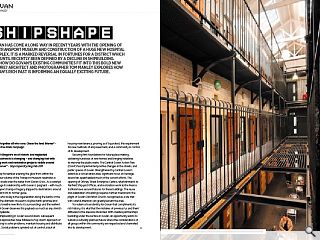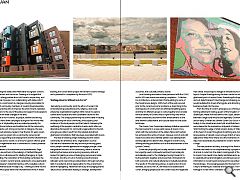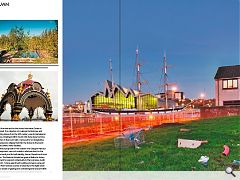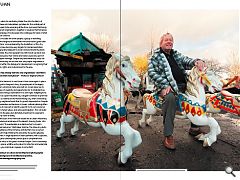Govan Renewal
13 Jan 2012
Govan has come a long way in event years with the opening of the Transport Museum and construction of a huge new hospital complex. It is a marked reversal in fortunes for a district which had until recently been defined by a decline in shipbuilding. But how do Govan's existing communities fit into this bold new future? Architect and photographer Tom Manley explores how Govan's rich past is informing an equally exciting future.
“Come together all who care. Chase the land thieves” – Pollock Free State Campaign“One of Glasgow’s most historic and neglected neighbourhoods is changing – and changing fast with building work and restoration projects visible around every corner” – Skyscrapercity blog Feb 2011
On a crisp November evening the glow from within the cavernous volume of the Transport Museum resembles a beacon visible over the water from Govan Cross. As a catalyst for change its relationship with Govan is poignant – with much of Glasgow’s transport legacy shipped to destinations around the world from its former guise.
For who today is the regeneration along the banks of the Clyde? The dramatic museum’s skyline marks promise and ability to breathe new life to its surroundings and the resilient Burgh of Govan deserves this payback as much as any stretch of the Clydeside
As Shipbuilding in Govan wound down, subsequent remedial approaches have followed a ‘top down’ approach of attempting to solve problems, maintain housing and distribute funding. Social problems spiraled out of control; a lack of housing maintenance, proving, as if by protest, the requirement for new methods of empowerment, and a community in control of its development.
Securing firm foundations for future place making, delivering hundreds of new homes and bringing initiatives to improve the public realm, The Central Govan Action Plan (CGAP) has implemented positive changes in the streets, and public spaces of Govan. Strengthened by Central Govan’s award as a conservation area, significant focus on heritage assets has spearheaded much of the current efforts. The opening of Orkney Street Enterprise Centre, refurbishments to Fairfield Shipyard Offices, and restoration work to the Pearce Institute have secured futures for these buildings. The reuse and adaptation of buildings requires further investment; the plight of Govan Old Parish Church, recognised as a site that with careful attention can greatly benefit the area.
To reclaim a true identity for Govan that compliments its rich history, it is vital that the mistakes of previous ‘us and them’ attitudes to the area are discarded. With creative partnerships bubbling under the surface in Govan, an opportunity exists to sustain a culturally planned future where the considerations of all groups within the community are respected and channeled into its development. Echoing this belief, artist Matt Baker recognizes Govan‘s inherent assets and resources. Drawing on a tangible link with everything positive about old Govan’s unique story, and what made it prosper, he is collaborating with fellow artist t s Beall, on a commission by Glasgow Housing Association to work with community members of Govan’s Riverside estate. Their art practice aims to improve the environment, reawaken connections to the soul of the place and support local people to be part of the wider changes in the area.
Govan is rich in stories. Its people, resilient and strong. From the Rent Strike campaigns during the First World War, to the loss of shipbuilding and associated prosperity, the demise of local cultures and tradition has hit the community hard. Despite such strong connection to Glasgow, the area has suffered extensive neglect. Over the last 30 years Govan Workspaces has grown into a community owned social enterprise supporting local employment and the refurbishment of premises across Govan. As a force for good it offers a great model for regeneration and is committed to Govan’s potential to reinvent itself.
Testament to its investment and achievements, Page and Park are partners in the redesign of Fairfield Shipyard Offices into a cultural asset for retelling the legacy of Clyde Shipbuilding. The restoration of this building symbolizes the reality of Govan’s current revival, replacing its once great public face to Glasgow’s industrial machine, with a valuable cultural and commercial asset in today’s city. Offering a further 18,000 sq ft of office space within the refurbishment of this A-listed building, the conservation project will reinvent Govan’s heritage and is planned for completion by the end of 2012.
‘Nothing About Us WIthout Us Is For Us’*
Reinvoking a community spirit, the ethos of Govan Folk University brings educational, arts, religious, and social enterprise organizations together within Govan to explore connections to place and new sustainable futures for the community. This unique partnership has a firm belief in valuing and respecting the local community, the buoyancy and resilience of the local people, and their talents. Delivering the well being of the people is central to its aims and it offers an alternative framework for community regeneration to flourish, emerging as a direct result from the isolated and almost ghettoized connotations that have been associated with Govan.
The idea of fostering a high wellbeing and low carbon community are ambitious aims. Organizations such as GalGael and Fablevision are very active at promoting grass roots, people-centred approaches to engage younger, often marginalized sections of the community, within a vision for bettering themselves and acquiring necessary skills and respect for gaining a sense of belonging, purpose and value for Govan. At a time of cuts in funding across the board, GalGael’s work overcoming social problems through nurturing skills in woodwork, and an appreciation for the environment, deserve highlighting. Fablevision are busy encouraging shared values and a conversation leading to strategic development outcomes, that culturally enhance Govan.
Local housing associations have partnered with the CGAP, and its 500 new homes are nearing completion – Collective, Do-Architecture, Anderson Bell Christie adding to some of the mixed tenure designs. With much of the work secured prior to the current economic problems, a silver lining to the slowing pace of construction has afforded breathing space and time for different groups to come together and consider the true identity of Govan; what is right for key sites which remain unresolved, and how further enhancements to the area entwine collaborative, and cultural ideas into the urban landscape.
The Govan Cross Townscape Heritage Initiative supported the improvements to a new public space at Govan Cross, which with the restoration of the Aitken Memorial Fountain has enhanced the centre of Govan. However, a lot of work still needs to be done and a familiar pattern sees development activity adjacent to derelict sites, integral to Govan’s story, offering exciting possibilities such as the refurbishment of the Lyceum Cinema.
Govan has physically and socially started to mend itself but urgently needs continued investment to provide jobs and alleviate poverty. The challenge moving forward is to tie the elements together and ensure that a framework for both economic and cultural enterprise is mutually beneficial. The results of 70’s planning policies, its destruction of local identities, as across the UK, still needs to be addressed in Govan. Bringing people back into Govan Road, the neglected main street, would require changes to infrastructure and road layout; Golspie Road bypassing the town centre has effectively ghettoized parts of central Govan. Reworking the fragmented and out-dated transport interchange and shopping centre would revitalize this street, offering jobs and attracting businesses back into the area.
From the time of Govan’s emergence as a fishing and farming settlement making up part of the Kingdom of Strathclyde, Water Row led down to the Clyde, sandwiched between a large burial mound (the legendary Doomster Hill) and an early Christian site. (where Govan Old Church stands today) As the industrial era took hold, small thatched cottages were cleared for the momentous shipyards of Harland and Wolf, fronting the edge of what remains today of ‘Water Row’. At the heart of Govan throughout its defining eras, today a large expanse of carpark covers a huge stretch of vacant land adjacent to Water Row where once the momentous hulls of ships were assembled. Its potential for Govan’s transformation is huge.
The new pontoon and ferry crossing to the Riverside Museum site needs to be complimented by a proper sense of arrival. A route from the oldest crossing point of the Clyde, to Govan Cross needs to be clearly reinstated and a space to celebrate arrival and navigation, providing access and information to Govan’s past and present incorporated into the landscape. Encouraging people into the heart of Govan is key to enlivening its character and townscape. The rich heritage in Govan offers a fantastic opportunity to draw people to the area and for the stories that made Govan to be presented. The collection of sculptural tombstones and freestanding stones from the 10th century, are of international importance. Displayed within Govan Old, these deserve to be an attraction in their own right, crying out for an imaginative and contemporary display that links the stones to the burial ground and offers visitor facilities.
A previous proposal for the creation of a Glasgow Harbour type development, was not rooted in what was best for the local community and its built identity, hence it faced much local opposition. The financial climate has given a lifeline for future development to respond contextually to the local area. Austin Smith Lord’s 7-storey apartment building on Pearce Lane just off Water Row restores a sense of urbanity to this tight urban site. Deep reveals of glazing and contrasting brick are set within a bold brick façade that conceals the steel frame structure.
Further plans for reinstating Water Row into the fabric of Govan have not materialized, yet ideas for this central part of Govan seem to be emerging all the time. A process that brings the different organizations together is required, that harnesses the knowledge of local people into a dialogue for ideas of what this place could be.
This includes the show people, a group of travelling circus and fairground entertainers whose ancestry goes back generations, once endeared by the forefathers of this city, but who have become easy targets for misrepresentation. Occupying land adjacent to Govan Old and stretching down to the water, the show people’s ties with Govan go back over a hundred years, their stories and culture a precious part of ‘the peoples heritage’. Despite any landownership issue, the local community are on their side, and proper negotiation is required within the dialogue for development, recognising their inclusion, rights, and cultural asset to the area.
“Govan has already had two eras of greatness - and that is two more than most places” – Professor Stephen Driscoll
It would be fantastic to see Govan’s time come again. A place so integral to Glasgow’s story; its people part of the legacy Glasgow’s empirical status was built on. Govan deserves to be a place of creativity and opportunity for its inhabitants as well as becoming a destination in its own right. Adapting to its position as a post industrial city, Glasgow continues to promote itself as a creative and forward thinking city, often overlooking the very neighbourhoods that its growth depended on. Despite the complexities and tensions in Govan, cultural planning offers a chance to reassert an identity, specific to its own resources through shared values, and active participation. This can build interest in the place but ultimately investment is required to make any vision a reality.
To the East of the Riverside estate lies an urban wilderness. The mysterious landscape of the derelict Graving Docks, stirs in the wind. “It reverberates as a silent anchor to Govan’s industrial memories’’ Matt Baker told me. The stone dry docks offer a glimpse of the immense activity that once occurred here. I can’t help thinking this should be the public gateway into Govan; A large expanse of urban parkland, with sculptures, lighting and contemporary landscape to compliment the fantastic relics of this great Victorian Empire. Set in a backdrop of open space, wildlife, and a place for reflection and waterside activity, you could even squeeze in some flats!
Tom Manley is an urban and architectural photographer with a background in architectural practice.
|
|
Read next: Findhorn
Read previous: South America
Back to January 2012
Browse Features Archive
Search
News
For more news from the industry visit our News section.
Features & Reports
For more information from the industry visit our Features & Reports section.






